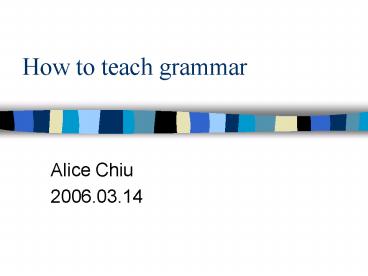How to teach grammar - PowerPoint PPT Presentation
1 / 20
Title:
How to teach grammar
Description:
a discrete set of meaningless decontextualized or static structure ... Fotos, S. (2001). Cognitive Approaches to Grammar Instruction. ( pp. 267-284) ... – PowerPoint PPT presentation
Number of Views:9964
Avg rating:5.0/5.0
Title: How to teach grammar
1
How to teach grammar
- Alice Chiu
- 2006.03.14
2
Main Menu
- What is grammar?
- What should be taught?
- How should it be taught?
- Examples of PPT slides
- Online Resources
3
1. What is grammar?
- Grammar is not
- a discrete set of meaningless decontextualized or
static structure - prescriptive rules about linguistic form
- What is grammar then?
4
2. What should be taught?A 3-D Grammar Framework
How is it formed?
What does it mean?
form/structure
meaning/semantics
use/pragmatics
When/Why is it used?
From Larsen-Freeman, D. (2001). Teaching
Grammar. (pp. 251-266). In Celce-Murcia, M.
(Ed.) Teaching English as a Second or Foreign
Language. (3rd Edition). Boston Heinle Heinle.
5
The advantages of the framework
It makes teachers understand the scope and
multidimensionality of the structure.
It helps teachers to identify the challenges.
6
2.1 Teaching form
- 20 questions (questions)
- family portraits (possessives)
- describing a person or a place by using relative
clauses - information gap activity (practice different
forms/patterns) - sentence-unscrambling task (a problem-solving
activity)
7
2.2 Teaching Meaning Making association between
form and meaning
- realia and pictures (comparative forms)
- actions
- TPR (imperative form)
- matching phrase-meaning association (phrasal
verbs) - story telling with action (phrasal verbs)
8
2.3 Teaching Use
- Role plays in different social contexts
- Example 1 giving advice
- Giving advice to friends
- Giving advice to young kids
- Advice columnist (speaking and writing)
- Example 2 past tense vs. present perfect
- Job interview
- Linguistic discourse context
- Teaching passive voices focus on issues rather
than agents - a text completion task
9
3. How should grammar be taught?
- 3.1 Accuracy vs. Fluency
- 3.2 Striking a Balance
- 3.3 from Cognitive Approach to
Communicative Approach - 3.4 Important features
- 3.5 Sequencing
- 3.6 Providing Feedback
- 3.7 General Guidelines
- 3.8 Conclusion
10
3.1 Accuracy vs. Fluency
11
3.2 How to strike a balance
- Fluency requires practice in which students use
the target language point meaningfully while
keeping the declarative knowledge in working
memory. - Meaningful practice of form
- Students have to receive feedback on the
accuracy. - Concentrate on one or two new forms at a time.
Repeated noticing and continued awareness of
the language feature is important.
12
3.3 From Cognitive Approach to Communicative
Practice
- Explicit formal instruction
- Structured-based communicative task
- Practice and production exercises
- Subsequent communicative exposure to the grammar
point
13
3.4 Important features
- consciousness raising
- either through teacher instruction (a deductive
method) - or by their own discovery learning (an inductive
method) - examples of the structure in communicative input
- opportunities to produce correct grammar points
14
3.5 Sequencing
- A grammar checklist
- Not following a prescribed sequence rigidly
- Many structures would arise naturally in the
course working on the tasks and content and would
be dealt with then.
15
3.6 Ways to Provide feedback
- Giving explicit rules
- Recasting
- Self-correcting
- Peer-correcting
- Collecting students errors, identifying the
prototypical ones, dealing with them
collectively in class as an anonymous fashion.
16
3.7 General Principles for Grammar Teaching
- little and often (recycle and revisit)
- planned and systematic
- offering learners a range of opportunities
- Involving acceptance of classroom code switching
and mother tongue - text-based, problem-solving grammar activities
- active corrective feedback and elicitation
- supported in meaning-oriented activities and tasks
17
3.8 Conclusion
- By thinking of grammar as a skill to be mastered,
rather than a set of rules to be memorized, well
be helping students go a long way toward the goal
of being able to accurately convey meaning in an
appropriate manner. - When the psychological conditions of learning and
application are matched, what has been learned is
more likely to be transfer. Therefore, presenting
rules and forms in the context of communicative
interaction is necessary.
18
4. Examples of PPT Slides
- Integrating ppt into grammar teaching
- Visual learners
- Interesting stories
- Examples
- .require that S V.
- Inversions (???)
- asas possible
19
5. Online resources for self-study
- Oxford University Press online practice
- Natural Grammar
- Oxford Learners Grammar
- The Good Grammar Book
- English works grammar exercises
- Big Dogs grammar
20
End of this Session
- References
- Larsen-Freeman, D. (2001). Teaching Grammar. (pp.
251-266). In Celce-Murcia, M. (Ed.) Teaching
English as a Second or Foreign Language. (3rd
Edition). Boston Heinle Heinle. - Fotos, S. (2001). Cognitive Approaches to Grammar
Instruction. (pp. 267-284). In Celce-Murcia, M.
(Ed.) Teaching English as a Second or Foreign
Language. (3rd Edition). Boston Heinle Heinle.

